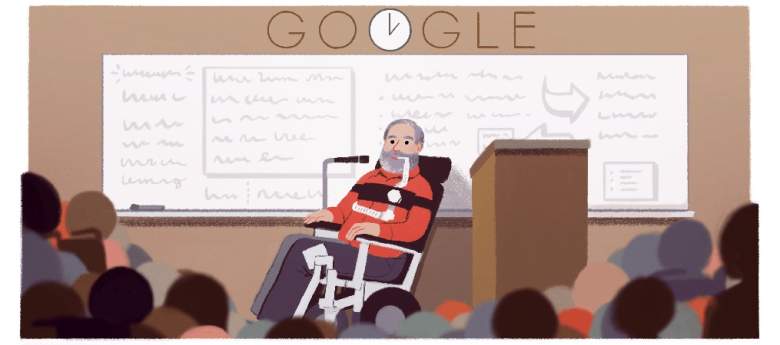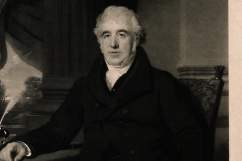
(Google)
Ed Roberts, the disability rights activist, is the subject of the January 23 Google Doodle. Roberts was born on January 23, 1939, and would be celebrating his 78th birthday, were he alive today. He died on March 14, 1995, at age 56 from a cardiac arrest.
“I watched Ed as he grew from a sports-loving kid, through bleak days of hopelessness, into self-acceptance of his physical limitations as he learned what was possible for him to accomplish,” his mother Zona once said, notes Google. “His years at UCB were great ones as he both enjoyed his college status and got in touch with his leadership qualities. He took great pleasure in watching people with disabilities achieve greater acceptance.”
Roberts was married to Catherine Roberts, although they divorced in 1982. He had a son named Lee.
Here’s a look at Roberts’ life and career.
1. Roberts Contracted Polio at Age 14 & Was Paralyzed From the Neck Down
When Roberts was 14 years old in 1953, he contracted polio. Jonas Salk’s vaccine would not be widely available for another two years.
According to his New York Times obituary, Roberts was paralyzed from the neck down and only had motion in one finger. He needed an iron lung or respirator to breathe.
“I’ve had people come up to me and say I’d rather be dead than be like you,” Roberts once said in a film called Free Wheeling. “And they miss it so much because life is such a joy. There’s so much to life if you’re into it. There’s so many reasons to die if you’re not at all.”
Before contracting polio, Roberts was an athletic man, according to Found SF. His mother, Zona, was pregnant with him while she was still a senior in high school and would joke that he graduated high school twice.
In a 1985 interview with California Monthly, Roberts said that his early days in rehab were difficult. He thought he was trying to kill himself, but eventually chose to live.
“It wasn’t a conscious effort, and the anorexia may actually have been a result of the disease,” Robert said. “But the day they took my last special-duty nurse away, I started to eat again. Talk about symbolism! All of a sudden I was on my own, and I had to make my own choices. Again, I chose life.”
In an in-depth oral history for the California State Archives, recorded a year before his death, Roberts recalled how his mother was completely surprised by his decision to go to UC Berkeley.
“I think I realized before she did that the path to my future and to my working or whatever was going to be education, totally,” Roberts said. “Because nobody was going to hire me the way I was. There was so much prejudice about disability.”
2. Roberts Became an Activist in High School, When He Was Denied a Diploma Because He Couldn’t Finish Gym Class
Roberts became an activist in high school when he was initially refused a diploma because he could not take physical education or pass driver’s education. Robert then had to file a petition to get his diploma, which he eventually received.
Roberts got an associate’s degree from the College of San Mateo before becoming the first severely disabled student to attend the University of California, Berkeley in 1962.
According to the Smithsonian Magazine, an official at UC Berkeley who was hesitant to admit him said, “We’ve tried cripples before and it didn’t work.” Since the Berkeley dormitories were not strong enough to house his iron lung, he had to live in the campus hospital.
Roberts told California Monthly that he knew administrators at the university couldn’t legally stop him from attending because he had great grades. They tried to say that he couldn’t live on campus, but he was invited to live at the hospital. He had to convince the director that he could live on his own.
“I insisted that I would have to be independent and not a patient – and he agreed,” Robert said. “He said I could hire my own attendants and that the hospital staff would be available at night if I needed them. It was like a dream come true, and I started at Berkeley in the fall of 1962.”
“When people would walk up to me, they would talk to my attendant,” Roberts recalled in a 1994 interview, notes the Smithsonian. “I was almost a nonentity.”
Roberts earned a bachelor’s and Master’s degree and spent his time at Berkeley helping to organize a self-help group for others with disabilities. He also taught political science at UC Berkeley.
3. Roberts Is Considered to Be the Father of the Independent Living Movement
Roberts is considered the father of the Independent Living Movement, although he was not the founder of Berkeley’s Center for Independent Living (CIL). He did work to transform it into what it is today and the model for other independent living centers around the country. Roberts was the executive director of Berkeley’s CIL from 1972 to 1975.
While at Berkeley, Roberts founded the university’s Physically Disabled Students Program, which was the foundation for the CIL.
The Ed Roberts Campus is named after Roberts and is designed to be accessible to everyone. It is a nonprofit organization that focuses on providing offices and spaces that are easily accessible to the disabled.
The Independent Living Movement began during the 1960s, with the hope that the disabled be able to control their own lives.
“People with disabilities do not see themselves as problems to be solved, and ask only for the same human and civil rights enjoyed by others,” the National Council on Independent Living notes. “Remarkably, this viewpoint is not generally accepted in society today and the Medical Model is still so deeply ingrained in us as a society that people with disabilities may spend their entire lives in nursing facilities often described as ‘tortuous’ or even be refused treatment at a hospital, and at a professional’s discretion, denied life-saving ‘futile care.'”
4. Jerry Brown Made Roberts the Director of the California Department of Vocational Rehabilitation in 1976
In 1976, California Governor Jerry Brown named Roberts the director of the California Department of Vocational Rehabilitation. The New York Times reported that, at the time, the department had 2,500 employees and a $140 million budget.
Found SF notes that this was the same organization that refused to provide UC Berkeley with additional funding to help Roberts attend because they considered him too disabled to find work after graduating. He was also the first to hold the position with a disability himself.
After eight years leading the department, Roberts spent the 1980s establishing the World Institute on Disability. The think tank is still active and is based in Berkeley.
In 1984, he received a MacArthur Foundation grant. He used the money to help the World Institute on Disability’s initiatives and he traveled the world to raise awareness of disability rights.
When California Weekly asked Roberts about what he hoped to accomplish with the MacArthur grant money, he said he hoped to wipe out polio.
Polio has almost been completely wiped out, but the disease does still exist. According to the World Health Organization, there were 74 reported cases in 2015. Afghanistan and Pakistan are the only two countries where the transmission of polio has not been stopped.
5. Roberts’ Wheelchair Is Now in the Smithsonian Institution
The Smithsonian Institution now houses Roberts’ wheelchair at the National Museum of American History.
Although Roberts didn’t initially use a power wheelchair, the wheelchair in the museum is one he later used. According to the Smithsonian, Roberts was not able to use a power wheelchair while at Berkeley because the lack of motion in his fingers made it impossible for him to control a remote controller that had to be pulled backwards to move forward. However, he later found that if you rotated the controller, he could use it so it could be pushed forwards to move in that direction.
“When he came into the room he captured people’s attention,” Joan Leon, a co-founder, with Roberts, of the World Institute on Disability, told the Smithsonian Magazine in 2015. “He kept that attention by moving his chair slightly—rolling it back and forth, lifting and lowering the foot pedals, and raising and releasing the back, even honking the horn or turning on the light.”
The wheelchair is not currently on view.
Roberts was a member of the sixth class of California Hall of Fame inductees, alongside Carlos Santana, Magic Johnson, Buzz Aldrin and The Beach Boys.
